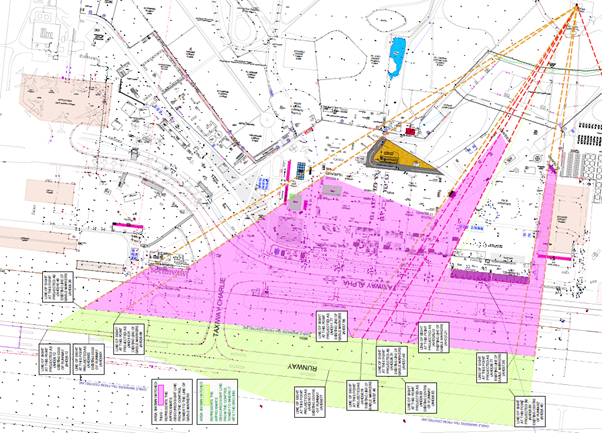On this page

Submit feedback to
Airservices is proposing temporary Air Traffic Services (ATS) procedures to manage a runway line-of-sight obstruction that will exist at Avalon Airport (YMAV) from January to April 2025
The issue
Civil Aviation Safety Regulations (CASR) Part 172 Manual of Standards (MOS) section 3.1.2.2(b) requires that air traffic controllers have an unobstructed view of the runway from a control tower. As a part of the biennial Avalon International Airshow, a series of temporary exhibition buildings, business units, and multi-tier seating grandstands are erected in preparation for the airshow.
The construction, use and dismantling of these structures causes a line-of-sight obstruction with the northern half of Avalon runway (RWY) 18/36, taxiway Charlie (TWY C), taxiway Bravo (TWY B) and a portion of taxiway Alpha (TWY A).
In order to continue to provide ATS at Avalon Airport when these temporary structures are in place, Airservices must apply for an exemption from the Part 172 MOS under CASR 172.095(4), with evidence that the proposed ATS procedures will be acceptably safe during the period where the view of the runway and manoeuvring area is obstructed from the control tower.
Purpose
The purpose of this consultation is to seek industry feedback on these proposed procedures, to ensure that any impact on Avalon operators is understood and minimised as far as is practicable.
Proposal
Airservices Australia is proposing temporary ATS procedures to manage a runway line-of-sight obstruction that will exist at YMAV from early January to mid-April 2025 due to temporary structures associated with the Avalon International Airshow.
The proposed ATS procedures will include two distinct modes of operation:
1. During periods of typical traffic demand, an Airport Safety Officer (ASO) will monitor the RWY and TWY for incursions and debris and relay these observations to the tower. Aircraft movements will be restricted to single aircraft operations, except when certain conditions are met (removing the potential for conflict). A NOTAM will be published during the period where single aircraft/movement operations are in place. Overflying Instrument Flight Rules (IFR) training flights will be restricted to not below 300 feet if they will be within 2 nautical miles, on final, whilst another aircraft is operating on the manoeuvering area. Vehicle and pedestrian operations within the obstructed area of the manoeuvering area, shall be restricted to:
- vehicles operated by an ASO; or
- aerodrome Rescue and Firefighting Service (ARFFS) vehicles; or
- vehicles escorted by the ASO.
2. Whilst any aircraft is on approach to land within 2 nautical miles or taking off; air traffic control shall manage traffic so that no aircraft, vehicle, or personnel may be on the manoeuvring area except:
- ASO or ARFF vehicles who are required to monitor the runway
- operations on TWY E and B that are restricted to the area east of TWY A
- Category C aircraft and above at the main apron may be pushed-back tail east to a position east of TWY A
- aircraft on TWY D, or on TWY A to the south of TWY D. Such aircraft must be instructed to hold short of the runway and must be visually monitored by air traffic controllers.
3. During periods where traffic demand is expected to be higher, the obstructed area will be monitored by a licensed air traffic controller with a current Aerodrome (AEROD) Rating (referred to as an ‘observer’). The observer may be located in a vehicle, in a Mobile Control Tower (MCT), or within the Forward Operating Centre (FOC) that is constructed specifically for the Airshow but must always be in a position where they can observe the obstructed area of the RWY/TWY. The observer is required to observe the partially obscured part of the RWY/TWYs and relay the status of the RWY/TWY with regards to obstructions via radio or recorded line to the Tower.
- Airservices will roster such an observer during daylight hours when R979 is active for the Avalon Airshow
- Airservices should deploy such an observer (when staff numbers permit) when any of the following conditions are met:
- during any other period where traffic analysis has forecast traffic demand is expected to be impactfully higher than average Avalon traffic levels (based on lookahead of IFR schedules)
- as deemed appropriate by the Avalon UTS/OCA
- significant fire-bombing operations are expected to occur during periods of medium to large-scale bushfires in Victoria, or when a total fire ban day has been declared. In this instance, an observer should be deployed to facilitate the unrestricted operations of these aircraft.
The following additional information will be included on the Automatic Terminal Information Service (ATIS): “RWY AND TWY xx OBSCURED FROM ATC DUE AIR SHOW BUILDINGS”.
Regarding any availability of an ASO/observer:
- if an ASO is not available for an extended period during Mode 1 operations, Airservices will consider utilising an observer
- if an observer is not available during Mode 2 operations, Airservices will revert to ASO/single aircraft operations.
